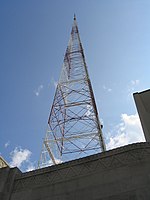Arthur Ashe Monument
Buildings and structures in Richmond, VirginiaMonument AvenueMonuments and memorials in VirginiaOutdoor sculptures in VirginiaSculptures of African Americans ... and 6 more
Sculptures of booksSculptures of children in VirginiaSculptures of men in VirginiaStatues in VirginiaStatues of sportspeopleVandalized works of art in Virginia
The Arthur Ashe Monument is a bronze sculpture by Paul DiPasquale installed along Richmond, Virginia's Monument Avenue. The statue depicts tennis player Arthur Ashe, who was born, raised and buried in Richmond.
Excerpt from the Wikipedia article Arthur Ashe Monument (License: CC BY-SA 3.0, Authors).Arthur Ashe Monument
Roseneath Road, Richmond Museum District
Geographical coordinates (GPS) Address Nearby Places Show on map
Geographical coordinates (GPS)
| Latitude | Longitude |
|---|---|
| N 37.5651 ° | E -77.479 ° |
Address
Roseneath Road 825
23221 Richmond, Museum District
Virginia, United States
Open on Google Maps








